
Bachman's warbler is a possibly extinct passerine migratory bird. This warbler was a migrant, breeding in swampy blackberry and cane thickets of the Southeastern and Midwestern United States and wintering in Cuba. There are some reports of the bird from the twenty-first century, but none are widely accepted. Some authorities accept a Louisiana sighting in August 1988 as confirmed, but the last uncontroversial sightings date to the 1960s.
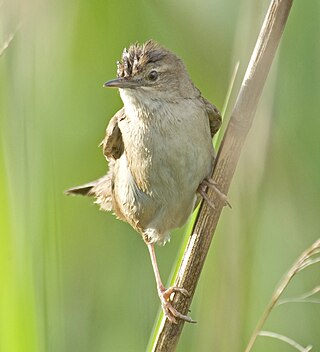
Savi's warbler is a species of Old World warbler in the grass warbler genus Locustella. It breeds in Europe and the western Palearctic. It is migratory, wintering in northern and sub-Saharan Africa.
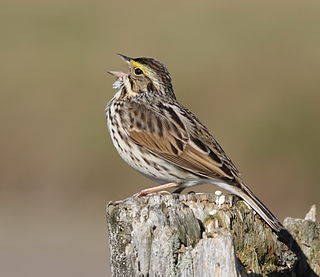
The Savannah sparrow is a small New World sparrow that is the only member of the genus Passerculus. It is a widespread and abundant species that occupies open grassland habitats in North America.
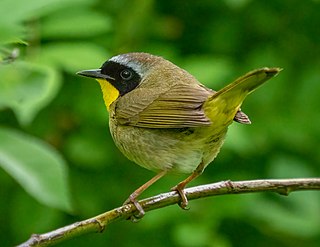
The common yellowthroat, also known as the yellow bandit or Maryland yellow-throat, is a New World warbler. It is an abundant breeder in North America, ranging from southern Canada to central Mexico. The genus name Geothlypis is from Ancient Greek geo, "ground", and thlupis, an unidentified small bird; thlypis is often used in the scientific names of New World warblers. The specific trichas is also from Greek; trikhas is a kind of thrush, the word being derived from trikhos, "hair".

The mourning warbler is a small songbird of the New World warbler family. Mourning warblers are native to eastern and central North America as well as some countries in Central America. They are neotropical migrants and tend to be found in dense second growth forests. They are under the Wood-warbler category, which consists of arboreal and terrestrial colorful passerines. Wood warblers are in the order Passeriformes, which are perching birds including more than half of all bird species, and the family Parulidae which also includes the Common Yellowthroat, Black and White Warbler, Nashville Warbler, ovenbird, and American Redstart. They are very similar to the MacGillivray's Warbler in appearance, especially in females and immature birds, but their breeding range does not overlap into the west.

The black-throated gray warbler or black-throated grey warbler is a passerine bird of the New World warbler family Parulidae. It is 13 cm (5.1 in) long and has gray and white plumage with black markings. The male has the bold black throat of its name, and black stripes on its head, as well as black streaks on its flanks; the female is a paler version of the male, with a white throat and less distinct black markings on the flanks and wings. It breeds in western North America from British Columbia to New Mexico, and winters in Mexico and the southwestern United States. The habitats it prefers are coniferous and mixed forests and scrubland, especially those with pinyon pines, junipers, sagebrush, and oaks. Its nest is an open cup of plant fibers lined with feathers, built a few metres from the ground in the branches of a tree or shrub. Three to five eggs are laid, and young are fed by both parents. Common in its breeding range, it does not seem to be seriously threatened by human activities, unlike many migratory warblers.

The Kentucky warbler is a small species of New World warbler. It is a sluggish and heavy warbler with a short tail, preferring to spend most of its time on or near the ground, except when singing.
The masked yellowthroat is a New World warbler. It has a number of separate resident breeding populations in South America. The black-lored yellowthroat and southern yellowthroat were formerly considered subspecies.
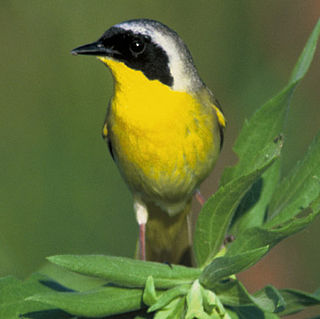
The yellowthroats are New World warblers in the genus Geothlypis. Most members of the group have localised ranges in Mexico and Central America, but the masked yellowthroat has an extensive South American distribution, while the common yellowthroat breeds over much of North America.

The Altamira yellowthroat is a New World warbler. It is a resident breeding bird endemic to the Gulf slope of north-eastern Mexico.

The Bahama yellowthroat is a New World warbler. It is a resident breeder endemic to the Bahamas.

Baird's junco is a species of junco, a group of small, grayish New World sparrows. It is endemic to the forests in the higher elevations of the Sierra de la Laguna mountain range of the southern Baja California peninsula in Baja California Sur, Mexico.

The black-polled yellowthroat is a species of bird in the family Parulidae.
The salt marsh common yellowthroat,, is a subspecies of the common yellowthroat, a New World warbler.

The black-lored yellowthroat is a New World warbler. It has a number of separate resident breeding populations in South America from western Ecuador to western Peru. It was previously considered a subspecies of the masked yellowthroat.
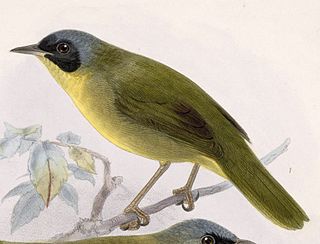
The Chiriqui yellowthroat is a New World warbler. It has a number of separate resident breeding populations in Central America from southwestern Costa Rica to Panama. It was previously considered a subspecies of the masked yellowthroat.

The southern yellowthroat is a New World warbler. It has a number of separate resident breeding populations in South America from southeastern Peru, eastern Bolivia, and south Amazonian Brazil to Argentina and Uruguay. It was previously considered a subspecies of the masked yellowthroat.

















